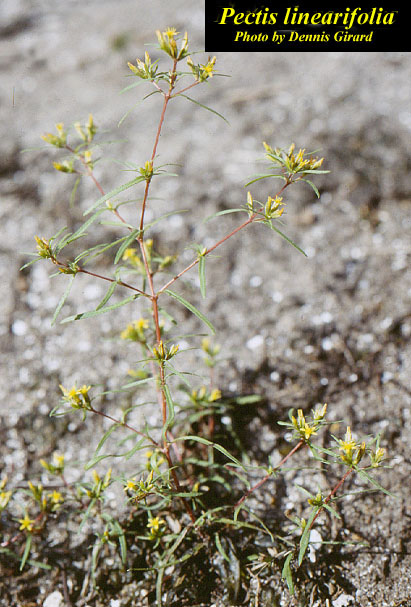Difference between revisions of "Pectis linearifolia"
Emmazeitler (talk | contribs) |
|||
| Line 51: | Line 51: | ||
Aphids are the only known parasites.<ref>Osorio R. 1990 ''Pectis linearifolia'' Palmetto 10(4):4</ref> | Aphids are the only known parasites.<ref>Osorio R. 1990 ''Pectis linearifolia'' Palmetto 10(4):4</ref> | ||
| − | ==Conservation and | + | ==Conservation, cultivation, and restoration== |
| − | == | + | ==Cultural use== |
==Photo Gallery== | ==Photo Gallery== | ||
<gallery widths=180px> | <gallery widths=180px> | ||
Revision as of 18:04, 8 June 2021
| Pectis linearifolia | |
|---|---|

| |
| Photo by Dennis Girard, Atlas of Florida Vascular Plants | |
| Scientific classification | |
| Kingdom: | Plantae |
| Division: | Magnoliophyta - Flowering plants |
| Class: | Magnoliopsida – Dicotyledons |
| Order: | Asterales |
| Family: | Asteraceae ⁄ Compositae |
| Genus: | Pectis |
| Species: | P. linearifolia |
| Binomial name | |
| Pectis linearifolia Urb. | |

| |
| Natural range of Pectis linearifolia from USDA NRCS Plants Database. | |
Common name: Florida chinchweed[1]
Contents
Taxonomic notes
Synonyms: none.[1]
Varieties: none.[1]
Description
A description of Pectis linearifolia is provided in The Flora of North America. It is a small, annual species that emits a lemon-citrus odor when crushed.[2]
Distribution
It is endemic to southern peninsular Florida,[2] specifically starting at Alachua County and continuing south.[1]
Ecology
Habitat
In the Coastal Plain in Florida, P. linearifolia has been observed in sand-shell scrubs, sandridges, abandoned railroad beds, and a cleared longleaf pineland with live oak, saw palmetto, Viburnum obovatum, cabbage palmetto, Fraxinus, Myrica and Salix. [3]
Phenology
P. linearifolia has been observed flowering and fruiting August through November. [3]
Seed bank and germination
Seeds germinate when scattered in pot or on the ground however have trouble growing indoors. [4]
Pollination
The following Hymenoptera families and species were observed visiting flowers of Pectis linearifolia at Archbold Biological Station: [5]
Halictidae: Augochlorella gratiosa, Lasioglossum nymphalis, L. puteulanum
Vespidae: Stenodynerus fundatiformis <===Diseases and parasites=== Aphids are the only known parasites.[6]
Conservation, cultivation, and restoration
Cultural use
Photo Gallery
References and notes
- ↑ 1.0 1.1 1.2 1.3 Weakley, A.S. 2015. Flora of the southern and mid-atlantic states. Working Draft of 21 May 2015. University of North Carolina at Chapel Hill, Chapel Hill, North Carolina.
- ↑ 2.0 2.1 [[1]] Accessed: February 18, 2016
- ↑ 3.0 3.1 Florida State University Robert K. Godfrey Herbarium database. URL: http://herbarium.bio.fsu.edu. Last accessed: October 2015. Collectors: Robert K. Godfrey, Olga Lakela, M. Menzel, Jackie Patman, James D. Ray Jr., D. Wise. States and Counties: Florida: Collier, Manatee, Polk, Sarasota. Compiled by Tall Timbers Research Station and Land Conservancy.
- ↑ Osorio R. 1990 Pectis linearifolia Palmetto 10(4):4
- ↑ Deyrup, M.A. and N.D. 2015. Database of observations of Hymenoptera visitations to flowers of plants on Archbold Biological Station, Florida, USA.
- ↑ Osorio R. 1990 Pectis linearifolia Palmetto 10(4):4